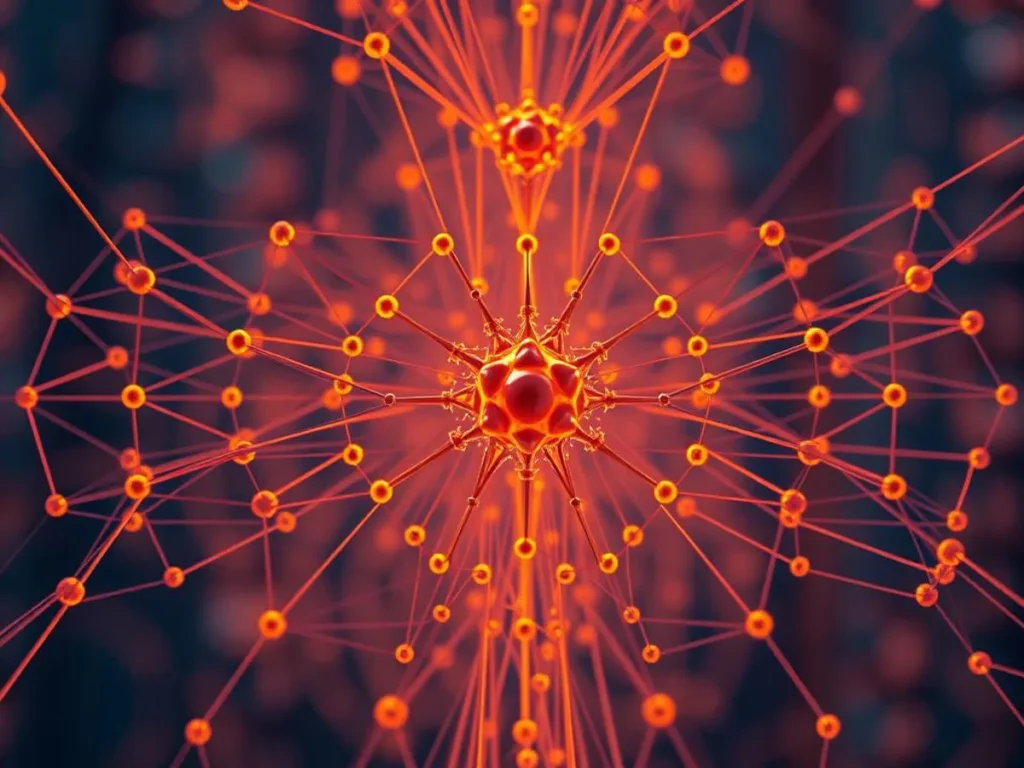Every day, over 2.5 quintillion bytes of data are made globally. Recurrent neural networks handle a big part of it. They are used in speech recognition and predicting stock markets.

Recurrent neural networks are a special kind of artificial intelligence. They are made to understand data that comes in a sequence. Unlike regular neural networks, they remember what happened before to help with what comes next.
This makes them great for tasks like predicting the weather or translating languages live. They can handle text, audio, and time-based data step by step. This lets them understand the context of a sentence or spot trends in financial data.
The growth of recurrent neural networks has changed fields like natural language processing and autonomous systems. They are key to modern AI, from virtual assistants to medical tools.
This article will dive into how recurrent neural networks work, their different types, and their uses in the real world. Find out why they are so important in artificial intelligence.
Introduction to Sequential Data Processing
Sequential data is key in many AI projects. It’s different from static data because it changes over time. This includes text, audio, and sensor readings. Traditional methods often fail to keep up, leading to errors.
Rnns were created to solve this problem. They process data step by step, keeping track of what happened before. This way, they can handle sequences better than older methods.
Understanding Sequence Challenges
There are three main challenges in processing sequences:
- Variable Length: Data like sentences or videos can be any length. Models need to be flexible.
- Context Dependency: What comes first affects what comes later. For example, grammar in sentences.
- Temporal Dynamics: The time between data points matters. It affects the outcome, like stock prices.
Significance in Modern AI
Rnns have led to big improvements in AI:
- Natural language processing for chatbots and translation tools.
- Speech recognition systems in virtual assistants.
- Time series forecasting for financial and weather predictions.
These models help turn raw data into useful insights. They’re crucial in healthcare, finance, and making systems work independently. Their skill in learning from order and timing is vital for solving real-world problems.
Fundamentals of Recurrent Neural Networks
RNNs use special designs and math to handle sequential data. Their setup and activation functions are key to their success. They can tackle tasks like language translation or speech recognition in deep learning systems.
Architecture Overview
RNN architecture is based on basic neural network ideas but adds loops for sequences. It has:
- Recurrent loops that pass data between layers
- Hidden layers storing past input information
- Connections enabling memory-like behavior
Functions in RNNs
Activation functions manage signal flow in the network. Common types are:
- Sigmoid: Smooths outputs between 0 and 1
- Tanh: Scales values between -1 and 1
- ReLU: Introduces nonlinearity for complex pattern recognition
These functions help RNNs avoid saturation. They adapt well to deep learning frameworks. Choosing the right ones ensures that networks handle time-based data well without losing context.
How Recurrent Neural Networks Work
Recurrent Neural Networks (RNNs) handle sequential data by keeping a memory of past inputs. When new data comes in, the hidden layer mixes it with what it has learned before. This makes the network’s output depend on both the past and the present.
- Data arrives in sequences, like words or time steps.
- The hidden layer updates its state using math functions, retaining context from earlier steps.
- Outputs are generated after processing each input, influenced by the evolving hidden state.
As time goes on, the network tweaks its weights to get closer to the right answers. It uses a special method called backpropagation through time. But old RNNs had a problem called vanishing gradients. This made it tough to remember long sequences.
Later, new designs like LSTM and GRU came along. They fixed the memory issue, making RNNs much better at handling long sequences.
Exploring RNN Variants and Architectures
Recurrent Neural Networks (RNNs) have evolved into specialized types to handle sequential data. Each type aims to balance complexity and performance for tasks like speech recognition or text generation. Here are some key innovations that shape modern applications:
- Elman Networks: These are early RNNs with context layers that store past inputs. They form basic memory loops. Though foundational, they face challenges with long-term dependencies.
- Gated Recurrent Units (GRU): GRUs are streamlined alternatives to LSTMs with fewer parameters. They merge gates into update and reset mechanisms. This speeds up training without losing much accuracy in shorter sequences.
When choosing, consider the task’s needs: LSTMs for complex temporal relationships, GRUs for efficiency, and Elman networks for simpler patterns. These architectures together tackle core RNN limitations. They expand RNNs’ use across various industries.
Implementing Recurrent Neural Networks in Deep Learning
To start building RNN models, you need to pick the right tools. Top frameworks make coding and training easier. This helps developers tackle complex algorithms.
Popular Frameworks
| Framework | Key Features | Use Cases |
|---|---|---|
| TensorFlow | Dynamic computation graphs, GPU acceleration | Text generation, speech recognition |
| PyTorch | Flexible, Pythonic syntax, eager execution | Time-series prediction, chatbots |
| Keras | User-friendly API, pre-trained models | Quick prototyping, sentiment analysis |
Step-by-Step Implementation
- First, define your problem and pick a framework. For example, TensorFlow is great for scalability.
- Next, get your sequential data ready. Normalize inputs and split them into training and validation sets.
- Then, create your RNN architecture. Use layers like LSTM or GRU cells.
- After that, compile your model. Choose loss functions (like categorical_crossentropy for classification) and optimizers (like Adam).
- Now, train your model. Keep an eye on performance and tweak hyperparameters as needed.
- Lastly, check your results with metrics like accuracy or mean squared error.
Applications in Natural Language Processing
RNNs are key in natural language processing for handling text and speech. They’re great at understanding context, like in Google Translate. This tool uses RNNs to translate phrases between languages.
Amazon uses RNNs in its sentiment analysis systems. These systems help figure out the tone in customer reviews. This is crucial for understanding what customers mean.
- Chatbots: RNNs help virtual assistants like Apple’s Siri respond like humans. They guess the next word based on what’s been said.
- Text Generation: Tools like OpenAI’s GPT models create paragraphs from just a few words. They use RNNs to make sure the text flows well.
- Spell Checking: Apps like Grammarly use RNNs to catch typos as you type. They look at the sequence of characters to spot mistakes.

Frameworks like TensorFlow and PyTorch make it easy to use RNNs in natural language processing. They help with tasks like summarizing documents and controlling devices with voice commands. RNNs are also important for analyzing chat logs and classifying documents in fields like healthcare and finance.
Time Series Analysis with RNNs
RNNs change how we analyze time series data. They find patterns in data over time. This helps in finance, healthcare, and more.
Forecasting and Trends
RNNs forecast the future by learning from past data. They are used in many ways:
- Stock market trends: Helping with investment plans
- Climate modeling: Better weather forecasts
- Energy demand: Using patterns to manage resources
Anomaly Detection in Time Series
RNNs spot oddities in data. They help in:
- Banking fraud detection: Catching unusual transactions
- Industrial monitoring: Predicting equipment failures
These skills are key for making smart decisions in data-rich fields.
Challenges in Training Recurrent Neural Networks
Training recurrent neural networks (RNNs) comes with its own set of problems. The main issues are vanishing gradients and exploding gradients. Vanishing gradients make learning slow or stop while exploding gradients cause big problems with weight updates. Both issues hurt the network’s ability to handle long sequences, leading to less accurate results over time.

To tackle these problems, developers use specific strategies. Some of the main methods include:
- Gradient clipping: This limits gradient values to stop them from getting too big during backpropagation.
- Architectural improvements: New designs like LSTM and GRU help keep important information over long sequences.
- Optimization adjustments: Using algorithms like Adam or RMSProp helps keep training stable by adjusting learning rates.
- Weight initialization: Starting weights with techniques like Xavier or He initialization helps the network learn better.
Fixing these challenges means finding the right mix of architecture and algorithm tweaks. Good solutions help RNNs work well with sequential data. This makes them useful for tasks like speech recognition and predicting financial trends.
Optimizing RNN Performance
To make RNNs better, we need to tweak their settings and how we train them. Two key ways to do this are by adjusting hyperparameters and using regularization. These steps help RNNs be both accurate and flexible.
Hyperparameter Tuning
Choosing the right hyperparameters is crucial for RNNs to learn well. Important settings include:
- Learning rate: How fast the model updates its weights
- Batch size: The number of examples seen at once
- Epoch count: The number of times the model sees all examples
- Layer configuration: The structure of the model
Using tools like a grid search can help find the best settings. Automated optimizers like Bayesian search make this easier.
Regularization Techniques
Regularization stops RNNs from becoming too specialized. It adds rules during training. Some common methods are:
| Technique | Function | Outcome |
|---|---|---|
| Dropout | Randomly turns off neurons during training | Makes the model use all features |
| L2 Regularization | Penalizes large weights | Encourages simpler models |
| Early Stopping | Stops training when performance peaks | Prevents overtraining and saves resources |
By using these techniques together, RNNs can perform at their best. Frameworks like TensorFlow and PyTorch offer tools to make this easier.
Future Trends in Neural Network Research
Neural network research is growing, leading to new ways to solve complex problems. New methods aim to improve what RNNs can do and fix old issues.

Emerging Techniques
Scientists are looking into attention mechanisms and transformers to better understand sequences. These tools help models focus on important data, making them faster. They also explore neural ODEs, mixing differential equations with RNNs for better time handling.
Integration with Hybrid Models
Hybrid systems mix RNNs with other models to enhance performance. Here are some examples:
| Hybrid Model | Components | Applications |
|---|---|---|
| RNN-CNN | RNN + Convolutional Layers | Video analysis, image captioning |
| RNN-Transformer | RNN + Transformer Blocks | Advanced NLP, multilingual tasks |
| RNN-GNN | RNN + Graph Neural Networks | Network traffic analysis, recommendation systems |
These new steps aim to tackle real-world data better. Tools like TensorFlow and PyTorch help developers work on these hybrid models.
Conclusion
Recurrent Neural Networks (RNNs) are key in AI for handling sequential data. They excel in processing time-based information. This makes them essential for tasks like natural language processing, stock market predictions, and speech recognition.
Innovations like LSTM and GRU architectures have overcome long-standing challenges. They allow for accurate predictions in long sequences. Despite issues like vanishing gradients, techniques like hyperparameter tuning and regularization improve their reliability.
RNNs are crucial in real-world applications, from healthcare diagnostics to autonomous systems. They adapt to changing data streams. Research is ongoing to combine RNNs with transformer models, making them more efficient for complex tasks.
As deep learning advances, RNNs continue to play a vital role in solving sequential problems. They face technical challenges but also make significant breakthroughs. Their importance is seen in technologies like chatbots and fraud detection, showing their lasting value in machine learning.
Table of Contents
FAQ
How do RNNs handle sequential data?
RNNs keep track of data by updating an internal state with each input. This helps them learn about the sequence’s temporal dynamics. It’s perfect for data where context matters a lot.
What are the main challenges in training RNNs?
Training RNNs can be tough due to vanishing and exploding gradients. These problems can slow down learning and impact performance. Special techniques are needed to overcome these challenges.
What are Long Short-Term Memory (LSTM) Networks?
They’re designed to handle long-term dependencies. LSTMs have memory cells that keep information for a long time.
Can you explain Gated Recurrent Units (GRU)?
Gated Recurrent Units (GRU) are similar to LSTMs but simpler. They combine two gates into one, making them more efficient. GRUs work well for sequential tasks without losing performance.
What frameworks are popular for implementing RNNs?
TensorFlow and PyTorch are the top choices for RNN implementation. They offer tools and libraries that make building and training RNNs easier.
What applications do RNNs have in natural language processing?
RNNs are key in natural language processing. They’re used for tasks like translation, sentiment analysis, and text generation. Their ability to grasp context and sequence is invaluable.
How do RNNs contribute to time series analysis?
RNNs excel in time series analysis. They can predict trends and detect anomalies accurately. This is crucial for industries that need real-time analytics.
What are some ways to optimize RNN performance?
To boost RNN performance, try hyperparameter tuning and regularization. These methods can improve accuracy and make models more robust against overfitting.
READ MORE ABOUT NEURAL NETWORKS FROM HERE


I’m often to blogging and i really appreciate your content. The article has actually peaks my interest. I’m going to bookmark your web site and maintain checking for brand spanking new information.
There is definately a lot to find out about this subject. I like all the points you made
naturally like your web site however you need to take a look at the spelling on several of your posts. A number of them are rife with spelling problems and I find it very bothersome to tell the truth on the other hand I will surely come again again.
For the reason that the admin of this site is working, no uncertainty very quickly it will be renowned, due to its quality contents.
You’ve made a complex topic simple.
Your writing style is engaging.
Perfectly balanced between detail and simplicity.
I’ll definitely be coming back for more.
This helped me a lot, thank you.
Looking forward to your next post!
I’ll definitely be coming back for more.
Thanks for making it so relatable.